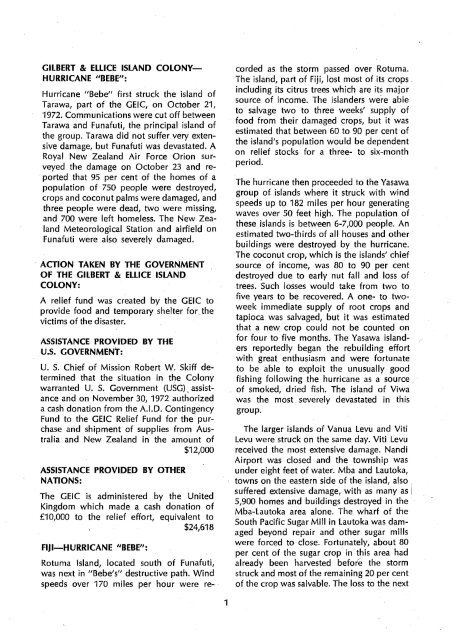QiSE REPORT Gilberi &Ellice Islands-Fiji-Tonga-Hurricanes Fall ...
QiSE REPORT Gilberi &Ellice Islands-Fiji-Tonga-Hurricanes Fall ...
QiSE REPORT Gilberi &Ellice Islands-Fiji-Tonga-Hurricanes Fall ...
Create successful ePaper yourself
Turn your PDF publications into a flip-book with our unique Google optimized e-Paper software.
GILBERT & ELLICE ISLAND COLONY<br />
HURRICANE "BEBE":<br />
Hurricane "Bebe" first struck the island of<br />
Tarawa, part of the GEIC, on October 21,<br />
1972. Communications were cut off between<br />
Tarawa and Funafuti, the principal island of<br />
the group. Tarawa did not suffer very extensive<br />
damage, but Funafuti was devastated. A<br />
Royal New Zealand Air Force Orion surveyed<br />
the damage on October 23 and reported<br />
that 95 per cent of the homes of a<br />
population of 750 people were destroyed,<br />
crops and coconut palms were damaged, and<br />
three people were dead, two were missing,<br />
and 700 were left homeless. The New Zealand<br />
Meteorological Station and airfield on<br />
Funafuti were also severely damaged.<br />
ACTION TAKEN BY THE GOVERNMENT<br />
OF THE GILBERT & ELLICE ISLAND<br />
COLONY:<br />
A relief fund was created by the GEIC to<br />
provide food and temporary shelter for. the<br />
victims of the disaster.<br />
ASSISTANCE PROVIDED BY THE<br />
U.S. GOVERNMENT:<br />
U. S. Chief of Mission Robert W. Skiff determined<br />
that the situation in the Colony<br />
warranted U. S. Government (USG). assistance<br />
and on November 30, 1972 authorized<br />
a cash donation from the A.I.D. Contingency<br />
Fund to the GEIC Relief Fund for the' purchase<br />
arid shipment of supplies from Australia<br />
and New Zealand in the amount of<br />
$12,000<br />
ASSISTANCE PROVIDED BY OTHER<br />
NATIONS:<br />
The GEIC is administered by the United<br />
Kingdom which made a cash donation of<br />
£10,000 to the relief effort, equivalent to<br />
$24,618<br />
FIJI-HURRICANE "BEBE":<br />
Rotuma Island, located south of Funafuti,<br />
was next in "Bebe's" destructive path. Wind<br />
speeds over 170 miles per hour were re-,<br />
corded as the storm passed over Rotuma.<br />
The island, part of <strong>Fiji</strong>, lost most of its crops,<br />
including its citrus trees which are its major<br />
source of income. The islanders we're able<br />
to salvage two to three weeks' supply of<br />
food from their damaged crops, but it was<br />
estimated that between 60 to 90 per cent of<br />
the island's population' wou Id be dependent<br />
on relief stocks for a three- to six-month<br />
period.<br />
The hurricane then proceeded to the Yasawa<br />
group of. islands where it stru'ck with wind<br />
speeds up to 182 miles per hour generating<br />
waves over 50 feet high. The population of<br />
these islands is between 6-7,000 people. An<br />
estimated two-thirds of all houses and other'<br />
buildings were destroyed by the hurricane.<br />
The coconut crop, which is the islands' chief<br />
source of income, was 80 to 90 per cent<br />
destroyed due to early nut fall and loss of<br />
trees. Such losses would take from two to<br />
five years to be recovered. A one- to twoweek<br />
immediate supply of root crops and<br />
tapioca was salvaged, but it was estimated<br />
that a new crop could not be counted on<br />
for four to five months. The Yasawa islanders<br />
reportedly began the rebuilding effort<br />
with great enthusiasm and were fortunate<br />
to be able to exploit the unusually good<br />
fishing following the hurricane as a source,<br />
of smoked, dried fish. The island of Viwa<br />
was the most severely devastated in this<br />
group.<br />
The larger islands of Vanua Levu and Viti<br />
Levu were struck on the same day. Viti Levu<br />
received the most extensive damage. Nandi<br />
Airport was closed and the township was<br />
under eight feet of water. Mba and lautoka,<br />
towns on the eastern side of the island, also I<br />
suffered extensive damage, with as many as<br />
5,900 homes and buildings destroyed in the<br />
Mba-lautoka area alone. The wharf of the<br />
South Pacific Sugar Mill in lautoka was damaged<br />
beyond repair and other sugar mills<br />
were forced to close. Fortunately, about 80<br />
per cent of the sugar crop in 'this area had<br />
al ready been harvested before the storm<br />
struck and most of the remaining 20 per cent<br />
of the crop was salvable. The loss to the next<br />
1
















